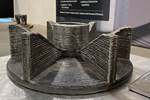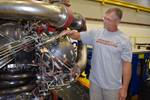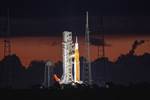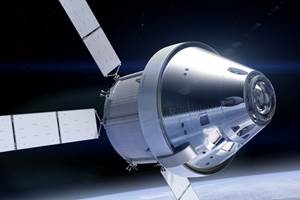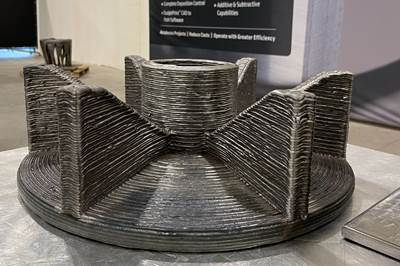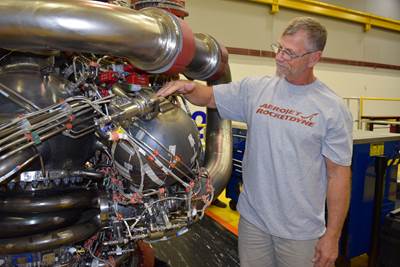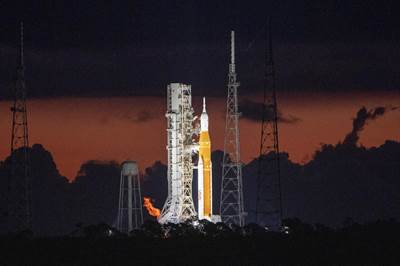At a recent reveal event in the company’s home city of Mesa, Arizona, large-format metal additive manufacturing startup Rosotics debuted its new “Mantis” system for 3D printing large pressurized vessel parts such as spacecraft tank, rocket stage and fuselage sections. Two innovations distinguish the company’s machine, both of which are evident in the photo below.

The Mantis system from Rosotics. Metal 3D printing with wire is performed using induction to melt the material. Large-diameter sections are printed onto rotary work surfaces like those seen at the floor of this photo. The machine configuration seen here is about 25 feet tall. Photo: Rosotics.
One innovation is the method of melting the material. Rosotics’ directed energy deposition system is wire-fed, but rather than a laser, it uses what the company terms “Rapid Induction Printing” to deposit material. The wire is fed through an electromagnetic coil generating heat in the metal via eddy currents.
This leads to several benefits, says co-founder and CEO Christian LaRosa. Two metal AM safety hazards, metal powder and lasers, are both avoided. Meanwhile, power consumption is less, to the extent that the machine can be run off a standard industrial electrical connection. “We are able to do this from a simple 240-volt outlet,” he says.
The other innovation is in the machine design. The Mantis system prints building-size metal structures, but it does not require a frame or gantry as large as these parts. The travel of the robot-like deposition arm is coordinated with a rotary work surface on which the cylindrical part grows.
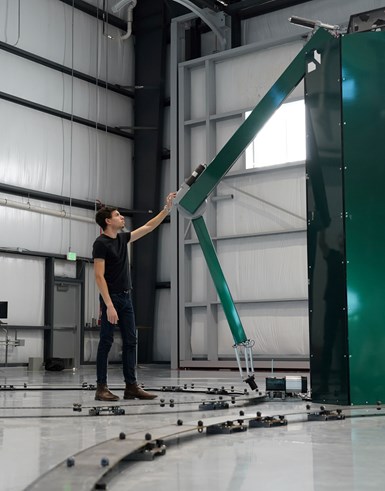
There is “an entire assembly stage we can now eliminate” in the production of large spacecraft sections, says CEO Christian LaRosa. Photo: Rosotics.
This rotary work surface is a modular component, changed out according to the size of the part being built, and today might accommodate parts up to 9 meters (30 feet) in diameter. Providing for rotary feed in this way leaves the motion of the print arm itself entirely free for controlling the metal deposition angle as the part turns, including printing unsupported overhangs.
LaRosa says, “If you can get those degrees of freedom from the system, you can begin to combine multiple components together, [such as] a tank section with an integrated dome taper at the top.” These are otherwise separate pieces. “Figuring out how to bring the large pieces together and get a friction stir weld between them — that is an entire assembly stage we can now eliminate by changing the process.”
Importantly, the reliance on eddy currents does not preclude non-conductive metals, he says. Aluminum is an important metal for the applications the company targets. In the case of this metal, rather than heating the feedstock directly, the induction can be used to heat an inner sleeve that in turn heats the metal. The Mantis has thus proven effective for printing with both steel and aluminum at a controlled deposition rate of 15 kg per hour. The modular system can also be configured to let up to three heads print the same part simultaneously, for a controlled rate of 50 kg per hour.
Production will begin on the first commercial Mantis systems later this year. To ensure affordability and allow Rosotics access for upgrading machines in the field, the company is not selling the system outright, but instead marketing it through a hardware-as-a-service model involving an entry fee and a recurring subscription price.
Related Content
This Drone Bird with 3D Printed Parts Mimics a Peregrine Falcon: The Cool Parts Show #66
The Drone Bird Company has developed aircraft that mimic birds of prey to scare off problem birds. The drones feature 3D printed fuselages made by Parts on Demand from ALM materials.
Read More6 Reasons Space Exploration Will Need Additive Manufacturing
There are at least half a dozen ways 3D printing will contribute to space travel, research and habitation — and in some cases it already is. Insights from seminar focused on manufacturing challenges for the space sector.
Read MoreDrones Take Flight with Metal and Polymer 3D Printed Parts: The Cool Parts Show Bonus
Drones produced by Cobra Aero now incorporate many 3D printed parts made through laser powder bed fusion and Multi Jet Fusion processes.
Read More8 Cool Parts From RAPID+TCT 2022: The Cool Parts Show #46
AM parts for applications from automotive to aircraft to furniture, in materials including ceramic, foam, metal and copper-coated polymer.
Read MoreRead Next
The Way Ahead for Wire Arc Additive Manufacturing
Tooling today, production tomorrow. The capability will advance as value is increasingly seen in lead time savings and design opportunities. Parts that today are cast offer a particularly promising application for a process that is “welding, except not.”
Read MoreSpace Launch System Accumulator is a Giant Leap for 3D Printing
A collaboration between Aerojet Rocketdyne and NASA is resulting in critical parts being 3D printed for new versions of the workhorse RS-25 engine.
Read MoreArtemis I Has Launched: 3D Printing Applications for This Space Mission and Beyond: AM Radio #25B
On this episode of AM Radio, we discuss how additive manufacturing is enabling a new era of space exploration.
Read More


